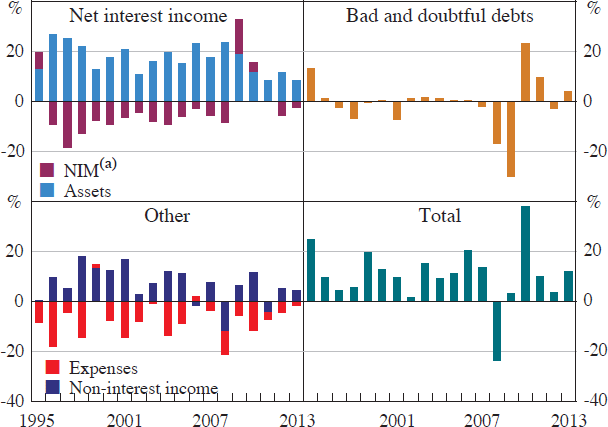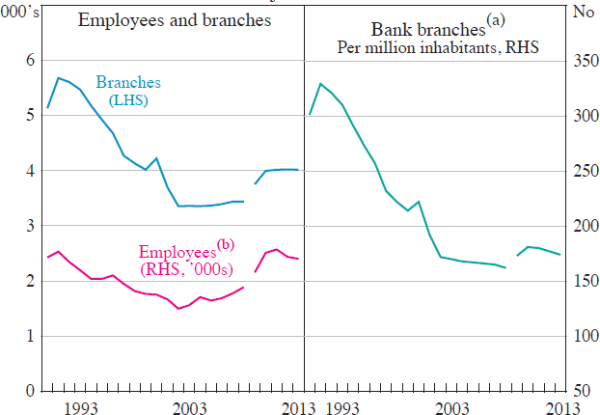RDP 2013-15: Trends in the Funding and Lending Behaviour of Australian Banks 4. Profitability
December 2013 – ISSN 1320-7229 (Print), ISSN 1448-5109 (Online)
- Download the Paper 1.07MB
Australian banks experienced strong profit growth in the 15 years leading up to the global financial crisis. Over this period, the profits of the major banks grew at an average rate of around 15 per cent per annum, while their post-tax return on equity also averaged about 15 per cent and their return on assets averaged around 1 per cent. Prior to the financial crisis, these rates of return were comparable to the returns of other large global banks (Figure 15).

Notes: Includes six US banks, eight euro area banks, four UK banks, three Japanese banks, six Canadian banks and four Australian banks; adjusted for significant mergers and acquisitions; reporting periods vary across jurisdictions
Sources: Bloomberg; RBA; SNL Financial; banks' annual and interim reports
Profitability over this period was supported by strong growth in net interest income, driven by a rise in interest-earning assets associated with the strong domestic demand for credit by both households and businesses (Figure 16). This rapid increase in assets was only partially offset by a sustained contraction in net interest margins due to increased competition. The major banks' return on assets also remained high throughout this period because they diversified their income through an expansion into wealth management services, assisted by the acquisition of wealth management companies, and steady improvements made to their operating efficiency.

Notes:
From 2006 data are on an IFRS basis, prior years are on an AGAAP basis; 2009 data are
adjusted for the acquisition of St. George
(a) The NIM (net interest margin) includes a cross-product term arising from the
interaction between margin compression and growth
Sources: authors' calculations; banks' financial reports
Improvements in efficiency prior to the financial crisis were achieved predominantly through reducing the prevalence of high-cost, low-value transaction banking services; a shift towards value-added services, such as wealth management; and a focus on a greater use of technology to streamline processing. Part of the efficiency improvements were achieved through a reduction in transactional banking branches during the 1990s (Figure 17). The reduction in branches over this period was not unique to Australia. The number of branches per capita declined in most, though not all, developed countries as banks strived to reduce operating costs and substitute electronic access for more costly branch access (RBA 1998).

Notes:
Break in series due to the acquisition of St. George by Westpac and Bankwest by CBA in
2009
(a) 2013 is estimated from March 2013 data; all other periods are end of financial
year
(b) Total group full-time equivalent employees
Sources: ABS; APRA; authors' calculations; banks' financial reports
A number of banking sector analysts, as well as APRA, have noted that banks might find it increasingly difficult to maintain their existing rate of profit growth (Laker 2012). Most notably, the slowdown in credit growth – from 12½ per cent per annum in the years prior to the financial crisis, to around 4 per cent per annum since 2008 – could weigh on profit growth over the medium to long term. Lower credit growth has stemmed from a change in the borrowing behaviour of households and businesses – in part following the completion of the transition to a lower interest rate environment – and a moderate tightening of lending standards. In the short term, the effects of lower asset growth are likely to be mitigated, in part, by a stabilisation in net interest margins apparent since the onset of the financial crisis, as well as cost-cutting programs designed to increase efficiency.
The major banks have renewed their focus on improving operating efficiencies with large-scale investments to upgrade their core banking systems and customer information systems. In contrast to the 1990s, however, the banks have complemented this strategy by repositioning their branches to focus on the sale of products, rather than traditional transactional banking operations. This strategy is designed to maximise the profitability of existing customers through better access to services and increased cross-selling of products. As a consequence, there has been some increase in both staff and branch numbers over recent years.
The implementation of the Basel III framework may also affect banks' profitability, although this is expected to be small (Littrell 2011). The requirement to hold more, and higher quality, liquid assets may lead to a decline in the average return on banks' assets. This is the case even in Australia, where the shortfall of high quality liquid assets is complemented with the operation of a committed liquidity facility. The commitment fee on the facility has been designed to reflect the liquidity risk of eligible securities held under this facility (Debelle 2013b). At the same time though, these reforms will lead to a decline in the average risk of bank assets and the volatility of their returns. The aggregate compensation demanded by all investors – both debt and equity – should therefore be lower than otherwise in response to this reduction in risk.